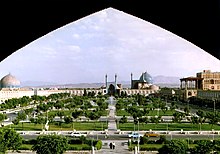


AnIranian architect is traditionally called a mi'mar (Persian: معمار, romanized: me'mâr; plural معماران me'mâran).
The Persian dictionary of Mo'in defines a mi'mar as:
Classical words Banna, Mohandes, Ostad, and Amal which appear in classical manuals and references of Islamic architecture.
Although many scholars do not recognize the Mimar and the Architect to historically be the same, they do agree that their responsibilities overlap extensively. In this list, they are taken to be the same.
The list is in chronological order and selectively spans the Islamic age based on available records. There is little, if any, record of the numerous masters of architecture that built some of the early Islamic and pre-Islamic world's wonders of Iran. It is unknown who built the palaces of Bishapur, Firuzabad, Persepolis, Susa, or the many other spectacular ancient edifices of Greater Iran. No record of their names exists. Only the ruins of what they built give us a faint indication of what masters must have walked the face of this earth eons ago.
Many of the structures remaining today possibly had more than one architect working on them. Only one is mentioned in the following list, and only their most famous work is mentioned. The list also contains the names of builders whom exact dates have been attributed to their buildings.







For a full comprehensive list of Iranian architects from antiquity up to the modern age, refer to: